 Submitted by Krishna on
Submitted by Krishna on
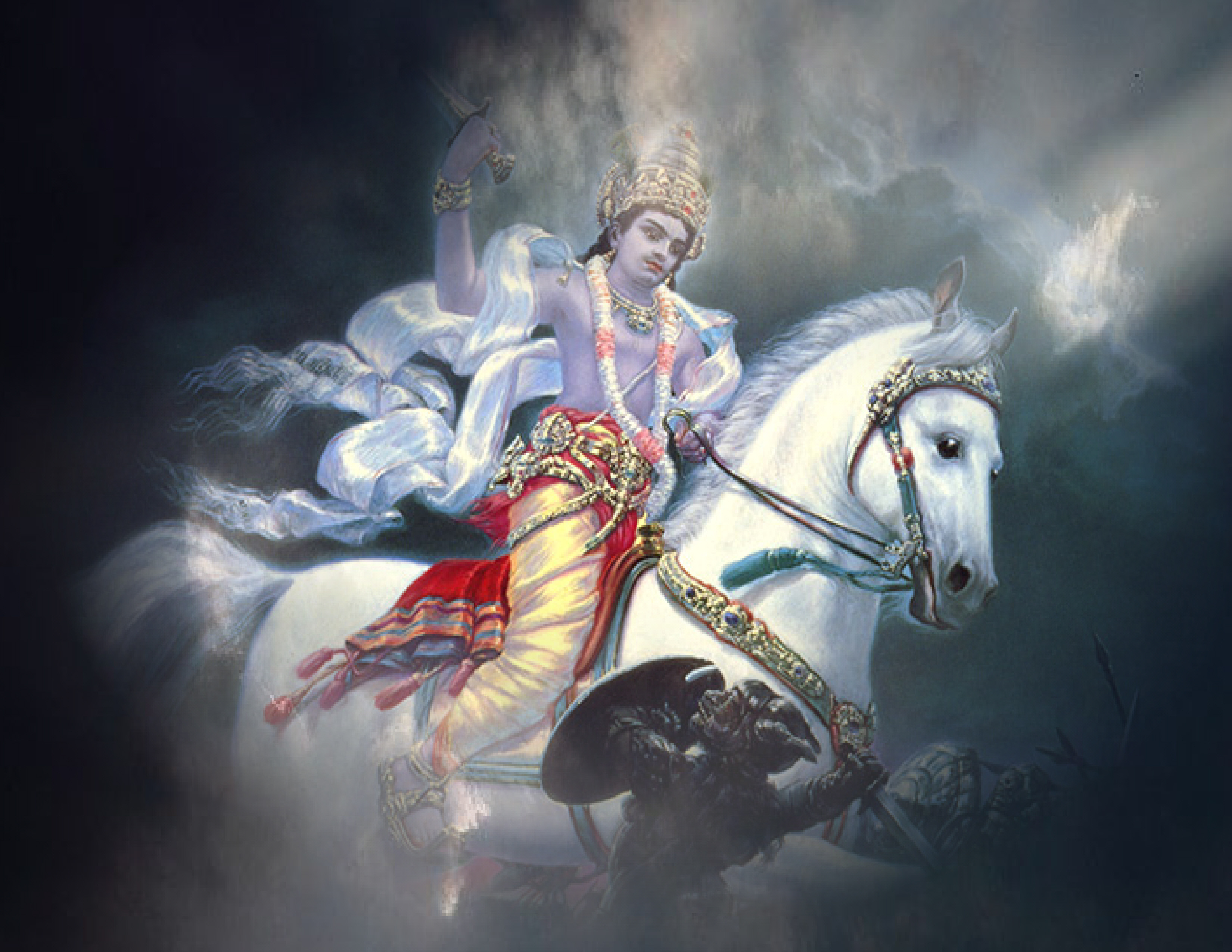
Deriviative Images
In Hindu Mythology, Kalki is the final incarnation of Vishnu, foretold to appear at the end of Kali Yuga, our currect epoch. The Puranas foretell that he will be atop a white horse with a drawn blazing sword. He is the harbinger of the end time in Hindu eschatology, after which he will usher in the Satya (Krita) Yuga or Golden Age.
The widespread belief that an age is ending and a new one dawning is part of a cyclical concept of time common to most philosophical cultures. The best known versions are the Four Ages of Greek mythology and the Hindu myth of the Four Yugas. The purpose of this article is to clarify some of the confusion that exists around them, to set out the actual figures as given by Eastern and Western authorities, and to discourage unthinking acceptance of a currently popular theory.1
The earliest European source of the myth is Hesiod, a Greek poet of the eighth century BCE. In his Works and Days (lines 109-21) he describes the ages as a cycle of decline, from Golden to Silver, Bronze, and Iron. He adds the interesting idea that these ages do not only change the quality of life, but the after-death state of humans. The people of the Golden and Silver Ages, when they died, became spirits who watch over and benefit the human race. The people of the Bronze Age were not immortal in that sense, but went down to a twilight existence in Hades. Perhaps influenced by the Trojan War, Hesiod here inserts an “Age of Heroes” of whom a few crossed the ocean to enjoy a private Golden Age under its ruler Cronos (Saturn). But this did not stem the degeneration for the rest of mankind, which hurtled down to the nadir of the Iron Age. For Hesiod it was too soon to tell their after-death fate, but things were not looking good for them.
Post-classical culture learned of the Four Ages mainly through Virgil and Ovid. In the first book of his Metamorphoses (I, 89-261) Ovid describes them and their races as declining in happiness and virtue until the universal Deluge. After that a new order of humans, animals, and plants was raised up from the earth. Christians saw a similarity with the biblical story of Noah’s Flood, but even more so in Virgil’s prophecy of a new Golden Age in his own time. It may have been intended to flatter the Emperor Augustus, who had brought peace after Rome’s civil war, but the mention of the Virgin made it applicable to Christ:
Now comes the last age, sung by the Cumaean Sibyl:
The great order of ages starts anew.
The Virgin returns and Saturn’s reign resumes:
A new race of men is sent from heaven.
(Eclogue IV, 5-8)
The Abrahamic religions (Judaism, Christianity, Islam) do not share the pagan concept of multiple cycles of creation and destruction. Monotheisms have room only for one cycle, with the Garden of Eden before the Fall as equivalent to the Golden Age. To continue the parallel, the Silver Age might be that of the biblical patriarchs who were still intimate with God; the Bronze Age that of the prophets and sacred kings; the Iron Age, from the Babylonian exile up to the present day. The cycle will end with Judgment, after which the Christian elect enter the New Jerusalem and Muslims the Garden of Paradise. Jews have their corresponding Messianic expectation. All three religions promise that in the end God will set things right, or in pagan language, that the reign of Cronos will return.
Incidentally, one of the recurrent themes of the Golden Age is that during it, the earth’s axis was perpendicular to the ecliptic (a topic treated in my book Arktos2). If this were so there would be no seasons, but equal day and night throughout the year. Plants and trees would fruit continuously, and the years would pass uncounted. Eternity could well describe the human experience of time under such conditions, which ceased when the axis was knocked off kilter. It will be restored at the next Golden Age, when the earth resumes its proper axial position. Whether or not there is any scientific basis to this myth makes no difference to its power and the “thought experiment” that goes along with it.
The Four Ages (Yugas) of Hinduism
Hindu tradition has its own version of the Four Ages, and it was probably from there that it reached the Greeks and other Indo-European peoples. The Puranas and Laws of Manu agree that the four Yugas are in the proportion 4:3:2:1. Their names are Krita Yuga (fortunate age; also called Satya Yuga), Treta Yuga (age of three parts), Dwapara Yuga (age of two parts), and Kali Yuga (age of conflict), the four together constituting a Maha Yuga or Great Age.
Each Yuga has a dawn and a twilight period, each a tenth of its length, called respectively Sandhyá and Sandyásana. The Vishnu Purana gives their durations in divine years, each counting for 360 human years, as follows:3
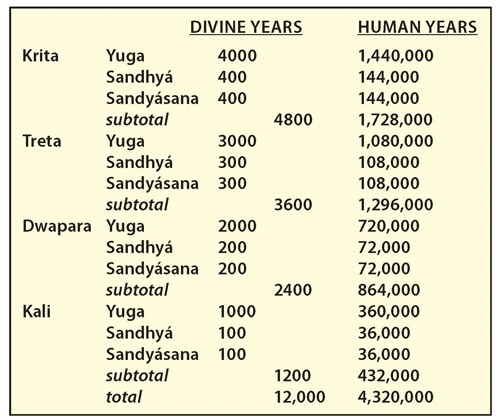
http://www.newdawnmagazine.com
To relate these durations to history we need an actual date, and this is supplied by the Hindu astronomers. They agree that the Kali Yuga began at midnight between February 17 and 18, 3102 BCE. From that we can calculate that the transition to the Golden Age will occur around 427,000 CE. It hardly seems worth bothering about something so far outside the time-scale of human experience. But before we dismiss these figures as pure fantasy, we should know that they are not peculiar to Hinduism. Some of them appear in very different contexts, with such precision that there is no question of chance coincidence.
Berossus, who records the Babylonian chronology, was a priest of Bel and had a school of astronomy on the island of Kos in the third century BCE. He gives the figures for the reigns of the ten Assyrian kings who preceded the Flood: they total 420,000 years.4
In China, according to the early missionary researcher Père Prémare, the early dynasties were respectively of 13 and 11 kings, each of whom ruled or lived 18,000 years. Prémare understandably doubted this, but if we do the arithmetic, (13 + 11) x 18,000 comes to 432,000 years.5
The Icelandic saga called the Poetic Edda describes the preparations for the apocalyptic battle at the end of time, when Valhalla’s warriors issue forth against the Fenris Wolf:
Five hundred doors | and forty there are,
I ween, in Valhall’s walls;
Eight hundred fighters | through one door fare
When to war with the wolf they go.6
800 fighters going through each of 540 doors totals 432,000. So the number of warriors gathered in Valhalla on the last day is again the number of years in the Kali Yuga, the last age of the Maha Yuga cycle.
The authors of Hamlet’s Mill, Giorgio de Santillana and Hertha von Dechend, called this a “remarkable and disturbing coincidence.”7 This is because the theory of an archaic worldwide culture with cosmological knowledge is anathema to official prehistory. One breach in the conventional view is due to Ernest McClain, one of the most original and ingenious researchers of our time. He has uncovered evidence of a kind of multidisciplinary game played with these self-same numbers which hinges on musical tuning systems. Those in the know included the Babylonians, the Vedic poets, Plato, the compilers of the Hebrew scriptures, the earliest Christians and Gnostics, and whoever gave the Quran its present form. For example, McClain interprets the Arks of Babylonian and Hebrew legend as multi-story diagrams that enclose, or “save” from the flood all possible numbers, the ones needed for calculating the calendar and the musical scale. In the case of Noah’s Ark, the significant number is none other than 432,000.8
McClain is a radical with regard to the history of ideas, but even more so are the Traditionalists, who take the numbers not as a philosophical game but as encoding precise knowledge of cosmic and historical time-cycles. René Guénon (1886-1951), one of the few great thinkers to have worked from this assumption, accepted that the four Yugas are in the proportion of 4:3:2:1, but questioned the Puranic figures. The zeros were put there simply to mislead, he says,9 and for good reason. If people knew the real dates, they would try to predict the future, which is unwise “because in practice, such knowledge brings many more problems than advantages.”10 The essential thing is the number 4320, which Guénon takes as representing the Maha Yuga: the set of four Yugas that embraces the entire history of present humanity. But 4320 years is obviously too short a period, just as the 4,320,000 years of the Puranas is too long. There were two basic problems: first, to find the correct multiplier of 4320 in order to arrive at the true length of the Maha Yuga, and second, to find the anchor in known chronology. Guénon seems to have worked backwards from knowledge of another cycle, that of the precession of the equinoxes which is traditionally given as 25,920 years (4320 x 6). Assuming that the Krita Yuga or the “timeless” Golden Age lasted for a whole precessional cycle, this gives the following durations for the four Yugas in human years, with a total of 64,800 years or 4320 x 15:
Krita, 25,920
Treta, 19,440
Dwapara, 12,960
Kali, 6480
For all his warnings about attempts to predict the future, Guénon planted straightforward clues, mostly in footnotes, to show how he connected these durations to known chronology. Writing about Atlantis, he says:
We think that the duration of the Atlantean civilisation must be equal to a “Great Year,” understood as half the period of the Precession of the Equinoxes. As for the cataclysm that brought it to an end, certain concordant data seem to indicate that it took place 7200 years before the year 720 of the Kali Yuga: a year which is itself the departure point of a familiar era, but one whose origin and significance are no longer known to those who currently use it.11
Guénon typically does not reveal the “concordant data,” but his commentator Jean Robin explains:
If one knows that the era in question is none other than the Jewish one, whose beginning is traditionally placed 3761 years before the Christian era, it is easy to deduce… the “theoretical” end-date of the cycle. The beginning of the Kali Yuga would thus be in the year 4481 BCE (3761 + 720), and its end would have to come 6480 years later, i.e. in the year 1999 (6480 – 4481).12
We can now reconstruct Guénon’s chronology as follows:
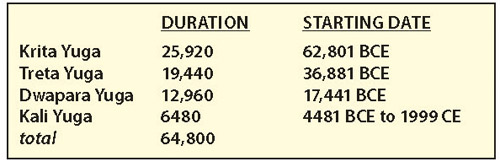
http://www.newdawnmagazine.com
Robin was writing in the early 1980s. He reminds us that 1999 is the one date specifically mentioned by Nostradamus as when “a great King of Terror will come from the sky.” But like every other world-ending date, it has come and gone.
The orientalist and musicologist Alain Daniélou (1907-1994) knew the Hindu tradition from the inside and was a correspondent of Guénon’s. He too could not accept the extremely large figures given in the Puranas, and reduced them in a different way. There are some problems with his method (explained in my book Atlantis and the Cycles of Time), but it is enough here to give his figures for comparison. Daniélou’s historical peg is the traditional date for the beginning of the Kali Yuga, 3102 BCE, which he says “represents a cosmological reality linked with an alternation in influx from the planetary spheres; it is not an arbitrary date.”13
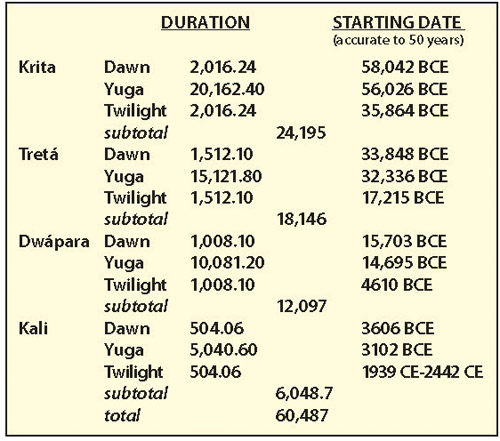
http://www.newdawnmagazine.com
By these calculations, the Kali Yuga’s final phase began with World War II. Daniélou, although a much more cheerful type than the saturnine Guénon, was a complete cultural pessimist. He writes that, “the final catastrophe will take place during this twilight. The last traces of this present humanity will have disappeared in 2442.”14 I can imagine him adding, with a smile, “et bon débarras!” [and good riddance!].
Guénon also corresponded with Gaston Georgel (1899-?), an independent scholar of whom almost nothing is known. He had found that historical events tend to replicate each other at certain rhythmical intervals. Some of his parallels are impressive, such as that of the medieval kings of France with Louis XIV-XVI, at an interval of 539 years (77 × 7), or that of the English and French revolutions, 144 years apart. Georgel first published his cyclical theories in 1937 as Les rythmes dans l’histoire (Rhythms in history).15 He was as yet unaware of Hindu traditions, and his large-scale cycle was one of 2160 years. This is the traditional duration of an astrological age, twelve of which make up the precessional cycle of 25,920 years. Georgel renames the Age of Aries the “Cycle of Abraham,” and the Age of Pisces the “Cycle of Caesar,” which he dates from 130 BCE. He arrived at that date, he says, from “a deep study of the Christic cycle” and the fact that “according to Virgil’s Fourth Eclogue, the sun at autumn equinox then entered the sign of Virgo.”16 That sounds authoritative, but as anyone who has studied the astrological ages should know, the borders of the constellations are not fixed (unlike the regular, fictive constellations counting from the spring point as 0° Aries). Consequently the time when the equinoctial sun moves from one to the next is debatable. For instance, the dates given by various authorities for the beginning of the Aquarian Age range from 1760 (Godfrey Higgins) to 2160 (Paul Le Cour).17
Guénon agreed that many of Georgel’s coincidences were extraordinary. The next year he wrote his own contribution to the subject, “Some Remarks on the Doctrine of Cosmic Cycles” (1938), in which he interpreted the Puranic numbers as given above. After World War II their correspondence resumed. Georgel returned the compliment by adopting Guénon’s Yuga chronology but stuck to his own dating, saying that “to facilitate our research, we will here adopt the date of AD 2030 that was proposed as a working hypothesis in our first book, for the end of the Manvantara” (i.e. the Maha Yuga of 64,800 years).18
Georgel found corroboration of the 2030 end-date in a book to which Guénon himself lent much credence: Beasts, Men and Gods by Ferdinand Ossendowski. This best-selling book published in 1922 plays a large role in the myth of Agarttha, which I have treated elsewhere.19 It culminated with a prophecy that the King of the World is supposed to have made in Mongolia in 1891:
In the fiftieth year only three great kingdoms will appear, which will exist happily seventy-one years. Afterwards there will be eighteen years of war and destruction. Then the peoples of Agharti will come up from their subterranean caverns to the surface of the earth.20
The fiftieth year from 1891 is 1941. The happy period of 71 years under three great kingdoms lasts from 1941 till 2012. Then 18 more years bring us exactly to 2030.21
We now have four suggested dates for the end of the Kali Yuga, and with it the end of the present set of four ages. The Puranic figures, taken literally, place it about 427,000 years in the future. Jean Robin, following Guénon, reckoned that it would end in 1999. Daniélou calculated that the Kali Yuga entered twilight phase in 1939 and will end completely in 2442. Georgel’s multiple cycles converge on the year 2030. After that a new Krita/Satya Yuga initiates the next cycle.
Sri Yukteswar’s Hindu Yuga system
Many readers will be familiar with the system proposed by Sri Yukteswar Giri (1855-1936). It has had such favourable publicity in recent years that it is widely believed to be the authoritative Hindu Yuga system.22 Sri Yukteswar adopts as his Maha Yuga a 24,000 year period, supposedly that of the precession of the equinoxes. He assigns half these years to a set of descending Yugas in the traditional proportion 4:3:2:1. By taking the “divine years” of the Puranas (see the first table, page 64) as human ones, they total 12,000 years. Then comes his real innovation: the cycle does not repeat, but starts a new set of four Yugas in reverse order. The link to historical chronology seems to be the traditional Kali Yuga starting-date of 3102 BCE, but moved to 3101 and to a different place in the Yuga sequence. From this it is easy to construct a table of Yuketeswar’s system:
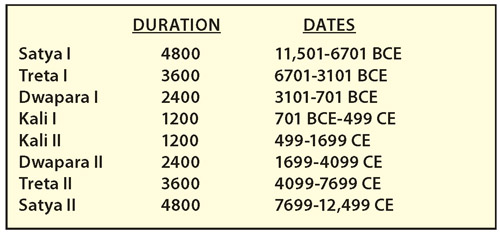
http://www.newdawnmagazine.com
As in the Puranic system, each age is framed by sandhis or periods of mutation at its beginning and end, each worth 1/10 of the Yuga. Thus a Kali Yuga proper lasts 1000 years, with periods of 200 years preceding and following it. In 1894 Yukteswar wrote:
In 1899, on completion of the period of 200 years of Dwapara Sandhi, the time of mutation, the True Dwapara Yuga of 2000 years will commence and will give to mankind in general a thorough understanding of the electricities and their attributes.23
The essence of Yukteswar’s system is that it places present-day humanity in an ascending, rather than a descending curve. This is so contrary to all traditions that we must look for its source elsewhere. Upper-caste Indians like Yukteswar may have resented being colonised by the British, but they had bought into the European myth of progress through science. Yukteswar believed that around 1700 the world had entered an “electrical” age. The discovery of electricity and its uses signified to him that man was attaining a finer perception than in the purely materialistic age that had preceded it. Before that, in the dual Kali Yuga, “the intellectual part of man was so much diminished that it could no longer comprehend anything beyond the gross material of creation.”24
Only historical ignorance can excuse such a statement. The period in question, from 701 BCE to 1699 CE, saw the birth of Buddhism, Zoroastrianism, Taoism, Jainism, and Vedanta; of the Orphic and Pythagorean movements, the mysteries of Isis, Serapis, and Mithras, the birth of post-exilic Judaism, Druidry, Christianity, Manicheanism, Gnosticism, Catharism, and Islam. On the esoteric side it witnessed Zen and Vajrayana Buddhism, Sankhya philosophy, Kabbalah, Sufism, theosophy both Neoplatonic and Christian, Rosicrucianism, and the arts of magic, alchemy, and astrology. Reports of miracles were commonplace, and belief in non-material realities such as oracles, curses, the Will of God, the Devil, transubstantiation, or witchcraft was so intense as to cause major wars and persecutions. Finally around 1700, with the scientific revolution and the Enlightenment, came a rising tide of disbelief in anything spiritual, leading to the atheism and scientific materialism of today’s elites.
The Jains and some Buddhist sects also had an up-and down cyclical system, which may have been one of Sri Yukteswar’s inspirations, though their time-scale far exceeds his. His other ingredient was a rough approximation of the precessional cycle to 24,000 years instead of the astronomers’ 25,770 or the traditional 25,920. He anchored it in historical chronology with a clearly political motive, for, along with another future guru, Sri Aurobindo Ghose, he belonged to a secret anti-colonial movement called precisely Yugantar, meaning “New Age” or “Transition of an Epoch.”25 There was a strategic purpose behind the announcement in 1894 that the Kali Yuga was over and the Dwapara Yuga, a better age, already in progress; also behind the emphasis on 1899, only five years away, as the year that the new epoch would come into its own. In the early years of the twentieth century, the movement’s propaganda announced that the “sinful Iron Age was over” and urged insurrection. This is not an attack on Sri Yukteswar and those who respect him and his disciple Yogananda, but simply a reminder that even sages have their agendas. Guénon said as much about the authors of the Puranas!

Image by DarkWorkX from http://Pixabay.com
What is at stake here is more than allegiance to one authority or another. It is whether one’s world-view allows (1) that humanity as a whole passes through predetermined cycles, and (2) that these are fixed chronologically, hence predictable if one can find the key. For what it is worth, I lean towards the first but not the second, because I trust the microcosm as a guide to understanding the macrocosm, and vice versa. Every one of us is passing through a predetermined cycle whose dates are unpredictable. Barring accidents, we are making our way from the Golden Age of childhood, through the bitter-sweet Silver Age of adolescence and the combative Bronze Age of maturity, to the Iron Age of decline and death. Then we may start afresh, but we certainly don’t repeat the process in reverse! Just as one can estimate someone’s life expectancy by their age, state of health, habits, etc., so one can make a guess at that of civilisations and maybe the entire human race.
The traditional descriptions of the Kali Yuga, and especially of what Guénon in 1944 called the “Reign of Quantity,” fit the modern world perfectly, and that may give us an idea of our position in the cycle. But like an old person recovering from one close call after another, we seem to be holding on and must be grateful for each new day.
Joscelyn Godwin
https://www.newdawnmagazine.com/articles/when-does-the-kali-yuga-end
© Copyright New Dawn Magazine, www.newdawnmagazine.com. Permission granted to freely distribute this article for non-commercial purposes if unedited and copied in full, including this notice.
© Copyright New Dawn Magazine, www.newdawnmagazine.com. Permission to re-send, post and place on web sites for non-commercial purposes, and if shown only in its entirety with no changes or additions. This notice must accompany all re-posting.
Footnotes
1. This article quotes and adapts material explained more fully in my book Atlantis and the Cycles of Time (Rochester, Vt.: Inner Traditions, 2011).
2. J. Godwin, Arktos, The Polar Myth in Science, Symbolism, and Nazi Survival (Kempton: Adventures Unlimited, 1996), 13-18.
3. Compiled from Vishnu Purana, 1:3; see also Linga Purana, 4:24-35; Laws of Manu, 1:68-82.
4. Eusebius, Chaldaean Chronicle, 1:8.
5. Joseph Henri Marie de Prémare, Discours préliminaire, in Joseph de Guignes, ed., Le Chou-King, un des livres sacrés des Chinois (Paris: Tilliard, 1770), li.
6. The Poetic Edda, Grimnismol, 23, trans. Henry Adams Bellows.
7. Giorgio de Santillana and Hertha von Dechend, Hamlet’s Mill: An Essay on Myth and the Frame of Time (Boston: Gambit, 1969), 162.
8. Ernest G. McClain, The Myth of Invariance: The Origin of the Gods, Mathematics and Music from the Rig Veda to Plato (New York: Nicolas Hays, 1976), 149.
9. What follows is summarised from René Guénon, “Quelques remarques sur la doctrine des cycles cosmiques,” in Formes traditionnelles et cycles cosmiques (Paris: Gallimard, 1970), 22-24.
10. Ibid., 21.
11. Ibid., 48n.
12. Jean Robin, Les sociétés secrètes au rendez-vous de l’apocalypse (Paris: Guy Trédaniel, 1985), 67.
13. Alain Daniélou, While the Gods Play: Shaiva Oracles and Predictions on the Cycles of History and the Destiny of Mankind, trans. Barbara Bailey et al. (Rochester, Vt.: Inner Traditions, 1987), 193.
14. Daniélou, While the Gods Play, 197.
15. Gaston Georgel, Les rythmes dans l’histoire, 3rd ed. (Milan: Archè, 1981; 1st ed. 1937).
16. Ibid., 164.
17. See Atlantis and the Cycles of Time, 346-48.
18. Gaston Georgel, Les quatre âges de l’humanité (Exposé de la doctrine traditionnelle des cycles cosmiques) (Milan: Archè, 1976; 1st ed. 1949), 87.
19. See J. Godwin, “Agarttha: Taking the Lid Off the Underground Kingdom,” New Dawn 109 (2008), 59-62; also the investigations by Marco Baistrocchi, “Agarttha: A Guénonian Manipulation?” trans. J. Godwin (Fullerton, Ca.: Theosophical History, 2011) and Louis de Maistre, Dans les coulisses de l’Agartha l’extraordinaire mission de Ferdinand Anton Ossendowski en Mongolie. (Paris: Arché, 2010).
20. Ferdinand Ossendowski, Beasts, Men and Gods (New York: Dutton, 1922), 314.
21. Gaston Georgel, Le cycle Judéo-Chrétien, sceau et couronnement de l’histoire humaine (Milan: Archè, 1983), 34.
22. This system is explained in Jnanavatar Swami Sri Yukteswar Giri, The Holy Science (Los Angeles: Self-Realization Fellowship, 1990; 1st ed. 1949), 7-18.
23. Ibid., 15.
24. Ibid., 13.
25. See Terrorism in Bengal: A Collection of Documents on Terrorist Activities from 1905 to 1939, ed. Amiya K. Samanta (Calcutta: Government of West Bengal, 1995), 1:155. Accessed through Wikipedia article “Mokshadacharan Samadhyayi.”
- 978 reads